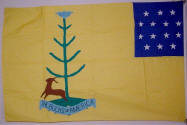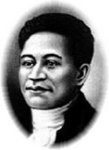 The
Bucks of America.
The
Bucks of America.Date: 1776.
Yellow field, pine tree, buck deer. Scroll, "Liberty or Death". [R27]
 This is
the flag of the first Afro-American company formed during the
Revolutionary War.
Crispus Attucks, an Afro-American, was reportedly the first American
casualty of the Revolutionary War. He was killed while leading a group
of American patriots in the controversial "Boston Massacre" of 1770.
This is
the flag of the first Afro-American company formed during the
Revolutionary War.
Crispus Attucks, an Afro-American, was reportedly the first American
casualty of the Revolutionary War. He was killed while leading a group
of American patriots in the controversial "Boston Massacre" of 1770.
Thousands of other Afro-American soldiers fought and died during the Revolution. After the war, Governor John Hancock presented this flag to a Black company for valor. It is autographed in a panel at the top of the pine tree by John Hancock and George Washington.
By 1776, more than a half million African Americans lived in the colonies. At first, the Continental Congress refused to let African Americans, whether free or enslaved, join the army. Some members doubted the loyalty of armed African Americans. The British, however, offered freedom to some male slaves who would serve the king. Washington feared that this would greatly increase the ranks of the British army. In response, Washington changed his policy and asked Congress to allow free African Americans to enlist. About 5.000 African Americans from all the colonies, except South Carolina, served in the army. Another 2000 served in the navy which, from the start, allowed African-Americans to join.
At least nine black minutemen saw actions at Lexington and Concord. Some African Americans formed special regiment (regimental flag above). Others served in white regiments as drummers, fifers, spies, and guides.
Enslaved African Americans faced difficult choices. If they joined the American army or continued to work on Patriot plantations, the British might capture and sell them. If they tried to flee to the British army to gain freedom, they risked being hanged by angry Patriots. Toward the end of the war several thousand slaves sought freedom by following British troops through the Carolinas.
Black Patriots hoped that the Revolution would bring an end to slavery. After all, the Declaration of Independence proclaimed that “all men are created equal.” Some white leaders also hoped the war would end slavery. During the American Revolution several states moved to make slavery illegal, including Massachusetts, New Hampshire, and Pennsylvania. Other states also began to debate the slavery issue.*
Read more about Afro-American participation in the Revolutionary War.
* Prentice Hall Social Studies 7th grade Text Book - "The American Nation" - P 187, 2002